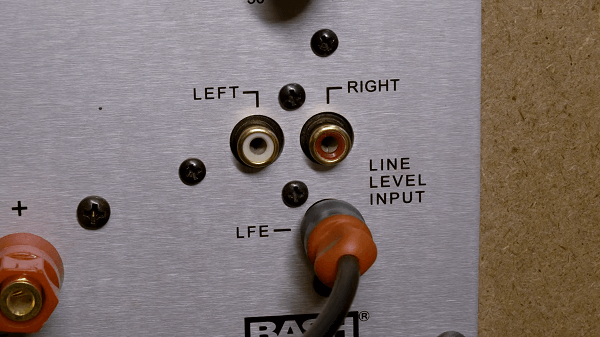Table of Contents
Depending on your situation, attempting to hook up your amplifier to your device can range from plugging in a few cables to doing some challenging DIY electrical engineering. Completing this task depends on several factors — whether your amplifier comes with an RCA jack, whether that RCA jack is functional, and if it’s capable of accepting high-level inputs.
Regardless of the source and the severity, we’ll give you a step-by-step guide on how to resolve these varying issues. Read more and find out how to bypass this surprisingly common issue.
How to Hook Up an Amp With RCA Jacks
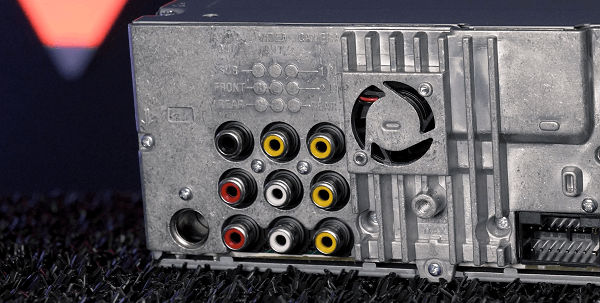
If you’re simply wondering how to hook up an amplifier with an RCA jack, this short guide will show you how.
- Step 1. – Find the RCA output sockets on your device before connecting it to the other electronics. On stereos and CD players, for example, they are typically on the back of the device.
- Step 2. – Connect the RCA cables to their corresponding inputs according to their matching colors.
- Step 3. – To see if the cable connections between the two devices are reliable, try playing a song. What you want to hear is a clear connection.
How to Hook Up an Amplifier Without RCA Jacks
Many amplifiers don’t include RCA Jacks. Luckily, there are several ways to get around this.
A relatively straightforward option for hooking up an amplifier without RCA jacks is through the use of an RCA converter. For the conversion process, you’ll need two RCA plugs, the converter itself, and a set of speaker cables.
Tools & Supplies
- RCA Adapter
- Line Output Converter
- Pliers
- Electrical tape
RCA Adapter
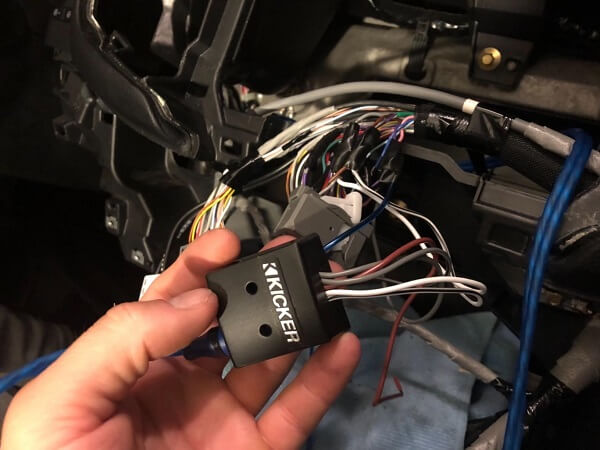
This item is a universal RCA adapter, meaning it’ll work for virtually any audio device. The versatility means you can use it in home speakers and car speakers, both of which have received incredibly positive feedback.
Before continuing, however, you must ensure your amplifier can accept high-level inputs from the RCAs. If it can’t, you’re going to need to make use of a line output converter (more on LOCs later).
Connect the adapter cable to the rear speaker and the speaker wires to the adapter cable.
Connect the adapter
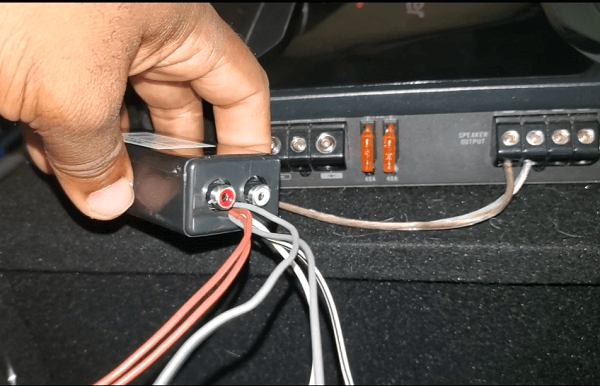
Connect the adapter to the RCA cable input on the amplifier.
If your amplifier’s RCA inputs are broken or incapable of accepting high-level inputs, you’ll have to use a line output converter.
Installing the Line Output Converter (LOC)
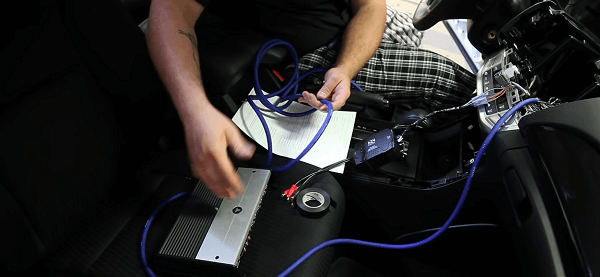
If you need to install a LOC, you’re going to need some wires, connectors, a wire remover, tape, a voltmeter, and a dependable line output converter.
Before going any further, we should explain what a line output converter does. A LOC acts in converting your car’s high output signal from the front or rear speakers into a low output signal, which you can then route to the amplifier. This functionality allows you to bypass any issues that arise with a broken or incompatible RCA input.
Locate the Factory Wiring Harness
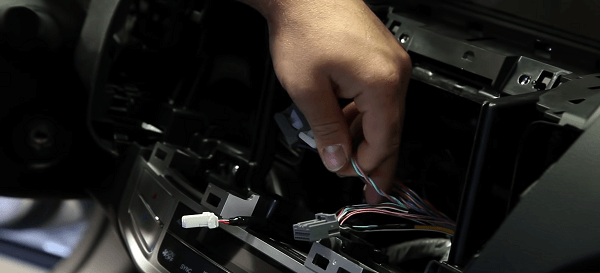
Typically beneath the head unit, the factory wiring harness is what will connect your OEM radio and car speakers to your amplifier.
What the Wires Mean

Different color wires signify either positive or negative terminals. The black wires are for the negative terminals, and red signifies the positive ones.
Be sure to read your car’s user guide before determining which is which, as you can greatly diminish audio quality if you incorrectly connect the wires.
Strip Away the Insulation

Remove about an inch of insulation from each of the wires, ensuring you don’t remove too much of it. You should route the left channel of the LOC to the left speaker and the right channel to the right speaker.
Hold the Wires Together

There are a few options for connecting the wires, depending on your preference. Either you can wind the two wires together, or if you’re looking for a more orderly method, you can use a butt connector to maintain a solid connection between the two twisted wires.
You can also use electrical tape if butt connectors are unavailable to you. Electrical tape’s durability makes it a fantastic alternative.
Ensure Configuration Is Functional
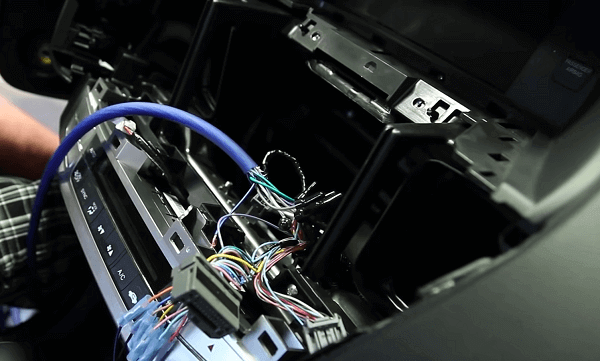
Turn on the car radio and play a song, ensuring the connections are functional.
How Do You Hook Up an RCA Cable to a Factory Radio?
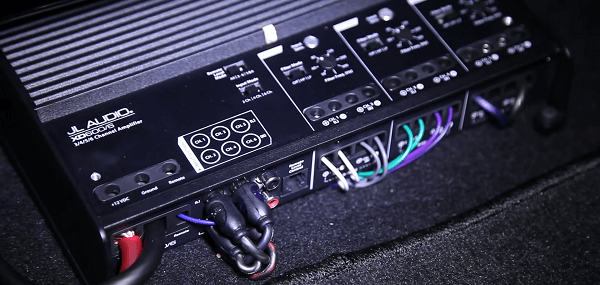
Some factory radios can be tricky when attempting to hook them up to an amplifier. With a few of the right tools, you should be able to hook it up with little help.
Before doing anything, make sure you have the unlock code (typically in the owner’s manual). You’ll be removing the head unit entirely, and this action will trigger the radio to lock up the next time you install it.
Car manufacturers design locking features as an anti-theft measure, and you’ll need the unlock code to regain access to it. Be careful when entering the code because you only get a few chances before the device locks up entirely. I’d recommend contacting the manufacturer if you forgot the code.
- Step 1. – Remove your head unit. There’s a large plug at the back of the stereo that connects all the inputs and outputs to and from the head unit. Finding a wiring schematic specific to your plug type is vital for this step to work properly. You can find these schematics on your car manufacturer’s website, or a local dealer could assist you. Ensure this plug is composed of all the sockets that correlate to the pins before attempting to plug it in. Then, verify your connection is correct using a multimeter. The multimeter should display the resistance between the + and – channels to be around 4 ohms. There should be approximately 12 volts between the ground pin and the 12-volt pin on the car’s chassis.
- Step 2. – Before mounting your converter unit, ensure there is enough wiring, allowing it to be securely connected back to the head unit cords. Be sure to mount it somewhere out of reach in your car, as it can be quite an inconvenience otherwise. Once you’ve found a good spot to mount your converter unit, solder the additional wiring needed from the converter unit to the head unit cables. After this step, be sure to insulate them with electrical tape or heat shrink tubing.
- Step 3. – Using Scotch Blocks, splice the wires from your head unit to the wiring needed by your converter. Use pliers to squeeze the metal splice bar to ensure a good connection. You can find the instructions for such wiring on the converters themselves. Perform voltage testing using the multimeter to confirm the connection is secure. Once you have confirmed the connection is secure, your converter should be ready for you to plug it into your amplifier or subwoofer.
Some Additional Notes
- Be sure to retest your connections with a multimeter to ensure all of them are connected properly. Depending on the type of converter, you should read between 5+ and 12+ volts.
- We recommend that you tape the Scotch Blocks together to prevent rattling and for proper cable management.
Frequently Asked Questions
Here are some additional questions related to amps and RCA cables.
Do factory stereos have RCA outputs?
Factory stereos don’t come readily equipped with RCA outputs and, therefore, you must install an RCA adapter to get it to function with most subwoofers/amplifiers. As with any external amps, make sure your adapter is secure after installation so the device doesn’t cause injury.
Where do you plug RCA cables into the head unit?
Plugging in the RCA cables likely requires removing the head unit and installing it into the internal wiring plug. You’ll want to connect the wires to the unit based on color for proper functionality.
Do RCA cables go to the input or output on an amp?
RCA cables go to input on an amp since they receive input signals from the receiver’s output. Amps typically don’t come with signal wiring because of the relationship between input and output through the RCA cables.
Can you install an amp without RCA jacks?
Installing an amplifier without an RCA jack is possible, given you have the right tools and adapters. As we’ve shown, you’ll either need an RCA adapter to feed the RCA cables through, or you’ll need to install an outlet line converter if your devices are incompatible.
Regardless, you should have a relatively easy time installing an amplifier without RCA jacks.
Hooking Up An Amp Without RCA Jacks
There are several ways to get around these issues regarding amplifier compatibility, and these are just a few of those methods. Hopefully, though, you’ve learned the basics of setting up your amplifier without an RCA jack and can now get to enjoying high-quality music in your car.

